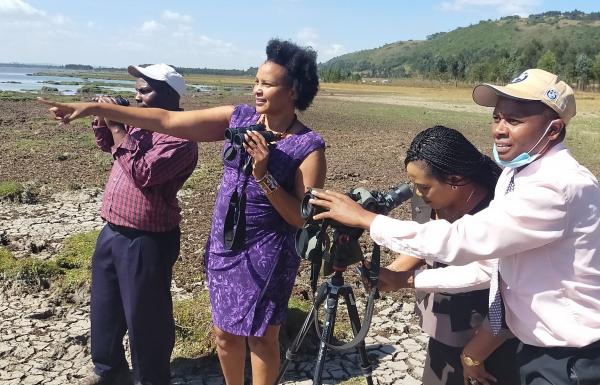Human Nature Conflicts affect Lake Olbolosatt in Central Kenya
By Faith Cherono Tanui
5 Sep 2022 by The Water Diplomat

Born 67 years ago, Mr. Wilson Muchiri, a father of five, has a long tale to tell about the Lake's ‘sweet times’ when he and his age mates went on fishing expeditions, hunting dikdik as they enjoyed the serene environment and chased the beautiful birds that made the lake a unique, enticing place to be.
He recalls the gifts from tourists visiting the lake for merry-making and hunting the birds.
But that was long ago, a kind of fun that started vanishing in the 1990's when the water levels from 43.3km² water body in Nyandarua County, Central Kenya region started diminishing. Today, a shallow water body is what remains of what was once a lake of about 4 meters deep, vanishing with all its glory, fauna, and flora. "It was a beautiful place to be, the lake was in the morning covered by a heavy dew which I think was vapour from the water body. The dew was so heavy covering the entire Shamata ranges at the Aberdare Forest," says the farmer.
Diminishing Lake Olbolosatt, the only freshwater body in the Central Kenya region, is attributed to the encroachment of the riparian lands, grabbing illegal farming at the Aberdare Forest, and blockage of water streams from the forest by prominent persons for irrigation purposes. Starting in the 1980s, powerful government officials were awarded hundreds of hectares of lakeside land by the Kanu regime, allocations that continue hurting the lake.
At about 7,600 feet above sea level at the foot of the Aberdare Forest, lake Olbolosatt is the only source of water for River Ewaso Nyiro feeding communities, livestock, and wildlife in Laikipia, Samburu, Isiolo, and Garissa Counties, with a tributary ending up in Somalia.
Due to political patronage and interests, both the county and national government ministries and departments are unable to conclusively reclaim the riparian land and end the illegal farming activities at the Aberdare Forest as the water body continues diminishing.
A report by the County Government of Nyandarua tourism department shows that with proper management, the lake can earn the county above Ksh600 million (US $ 5 million) annually. Former Cabinet Secretary for Environment and Natural Resources Professor Judi Wakhungu made the first attempt to reclaim and restore the lake in 2018 when she gazetted the water body as a wetland protected area, but nothing much has happened. Nevertheless, Lands Principal Secretary Nicholus Muraguri is optimistic the lake land will eventually be repossessed paving way for other developments.The PS says the Ethics and Anti-Corruption Commission (EACC) is investigating the land grabbing around the lake for repossession.
Successful repossession of the lakes land will pave way for Ksh1.7 billion (US $ 14 million) revival of the water body by the County Government of Nyandarua in partnership with local and international environment stakeholders and the donor community including the World Bank, The National Environment Management Authority, Kenya Forest Service, Community based organizations, and Kenya Wildlife Services among others.
Environment Cabinet Secretary Keriako Tobiko says the Ksh1.7 billion strategic plan identifies priority interventions under seven management programs; Biodiversity management, Eco-tourism management, Water resources management, Human-wildlife conflict management, Education and community awareness, Agriculture, Livestock and Fisheries management as well as Forestry resources management.
"Successful implementation of this Plan will facilitate rehabilitation of degraded areas; enhance ecological integrity and conservation. A huge amount of these resources goes to promoting eco-tourism and the blue economy around the lake, rehabilitation of the ecosystem, and agricultural-related activities," said CS Tobiko.
Before its current state, the lake was home to over 300 species of migratory birds from European countries and thousands of hippos that are today the main source of human-wildlife conflict.
